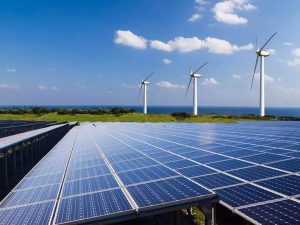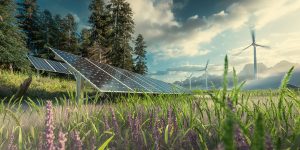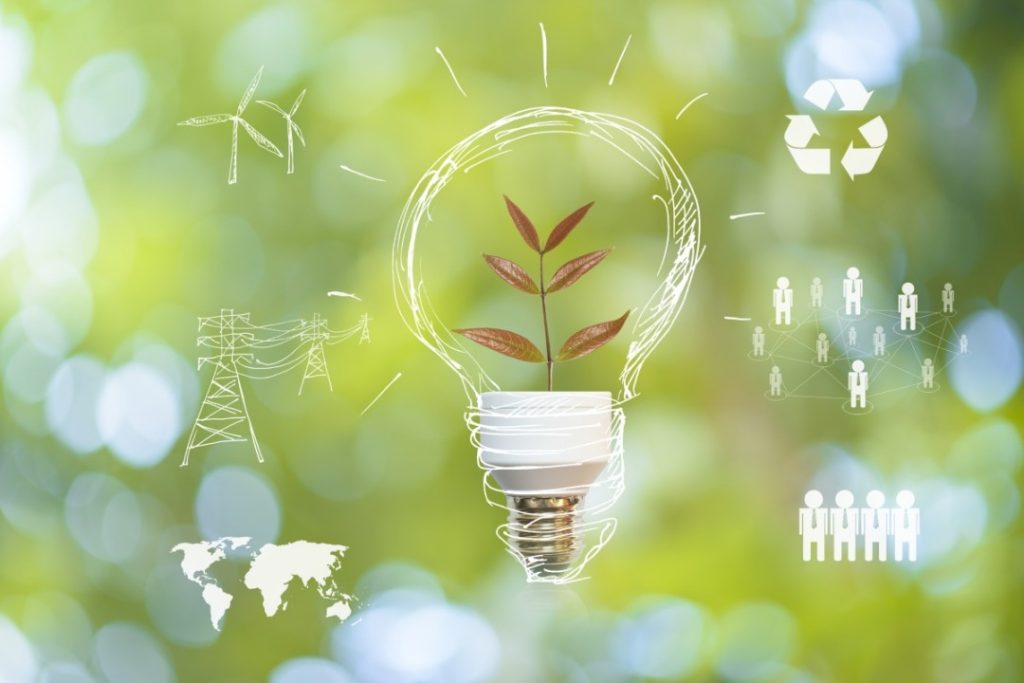
Green Energy.
As a source of energy, green energy often comes from renewable energy technologies such as solar energy, wind power, geothermal energy, biomass and hydroelectric power. Each of these technologies works in different ways, whether that is by taking power from the sun, as with solar panels, or using wind turbines or the flow of water to generate energy.
What Does it Mean?
In order to be deemed green energy, a resource cannot produce pollution, such as is found with fossil fuels. This means that not all sources used by the renewable energy industry are green. For example, power generation that burns organic material from sustainable forests may be renewable, but it is not necessarily green, due to the CO2 produced by the burning process itself.
Green energy sources are usually naturally replenished, as opposed to fossil fuel sources like natural gas or coal, which can take millions of years to develop. Green sources also often avoid mining or drilling operations that can be damaging to eco-systems.
Types
The main sources are wind energy, solar power and hydroelectric power (including tidal energy, which uses ocean energy from the tides in the sea). Solar and wind power are able to be produced on a small scale at people’s homes or alternatively, they can be generated on a larger, industrial scale.
The six most common forms are as follows:
1. Solar Power
This common type of renewable energy is usually produced using photovoltaic cells that capture sunlight and turn it into electricity. Solar power is also used to heat buildings and for hot water as well as for cooking and lighting. Solar power has now become affordable enough to be used for domestic purposes including garden lighting, although it is also used on a larger scale to power entire neighbourhoods.
2. Wind Power
Particularly suited to offshore and higher altitude sites, wind energy uses the power of the flow of air around the world to push turbines that then generate electricity.
3. Hydropower
Also known as hydroelectric power, this type of green energy uses the flow of water in rivers, streams, dams or elsewhere to produce electricity. Hydropower can even work on a small scale using the flow of water through pipes in the home or can come from evaporation, rainfall or the tides in the oceans.
Exactly how ‘green’ the following three types of green energy are is dependent on how they are created…
4. Geothermal Energy
This type of green power uses thermal energy that has been stored just under the earth’s crust. While this resource requires drilling to access, thereby calling the environmental impact into question, it is a huge resource once tapped into. Geothermal energy has been used for bathing in hot springs for thousands of years and this same resource can be used for steam to turn turbines and generate electricity. The energy stored under the United States alone is enough to produce 10 times as much electricity as coal currently can. While some nations, such as Iceland, have easy-to-access geothermal resources, it is a resource that is reliant on location for ease of use, and to be fully ‘green’ the drilling procedures need to be closely monitored.
5. Biomass
This renewable resource also needs to be carefully managed in order to be truly labelled as a ‘green energy’ source. Biomass power plants use wood waste, sawdust and combustible organic agricultural waste to create energy. While the burning of these materials releases greenhouse gas these emissions are still far lower than those from petroleum-based fuels.
6. Biofuels
Rather than burning biomass as mentioned above, these organic materials can be transformed into fuel such as ethanol and biodiesel. Having supplied just 2.7% of the world’s fuel for transport in 2010, the biofuels are estimated to have the capacity to meet over 25% of global transportation fuel demand by 2050.
Why It Is Important
Green energy is important for the environment as it replaces the negative effects of fossil fuels with more environmentally-friendly alternatives. Derived from natural resources, green energy is also often renewable and clean, meaning that they emit no or few greenhouse gases and are often readily available.
Even when the full life cycle of a green energy source is taken into consideration, they release far less greenhouse gases than fossil fuels, as well as few or low levels of air pollutants. This is not just good for the planet but is also better for the health of people and animals that have to breathe the air.
Green energy can also lead to stable energy prices as these sources are often produced locally and are not as affected by geopolitical crisis, price spikes or supply chain disruptions. The economic benefits also include job creation in building the facilities that often serve the communities where the workers are employed. Renewable energy saw the creation of 11 million jobs worldwide in 2018, with this number set to grow as we strive to meet targets such as net zero.
Due to the local nature of energy production through sources like solar and wind power, the energy infrastructure is more flexible and less dependent on centralised sources that can lead to disruption as well as being less resilient to weather related climate change.
Green energy also represents a low cost solution for the energy needs of many parts of the world. This will only improve as costs continue to fall, further increasing the accessibility of green energy, especially in the developing world.

Examples
There are plenty of examples of green energy in use today, from energy production through to thermal heating for buildings, off-highway and transport. Many industries are investigating green solutions and here are a few examples:
1. Heating and Cooling in Buildings
Green energy solutions are being used for buildings ranging from large office blocks to people’s homes. These include solar water heaters, biomass fuelled boilers and direct heat from geothermal, as well as cooling systems powered by renewable sources.
2. Industrial Processes
Renewable heat for industrial processes can be run using biomass or renewable electricity. Hydrogen is now a large provider of renewable energy for the cement, iron, steel and chemical industries.
3. Transport
Sustainable biofuels and renewable electricity are growing in use for transportation across multiple industry sectors. Automotive is an obvious example as electrification advances to replace fossil fuels, but aerospace and construction are other areas that are actively investigating electrification.
Can It Replace Fossil Fuels?
Green energy has the capacity to replace fossil fuels in the future, however it may require varied production from different means to achieve this. Geothermal, for example, is particularly effective in places where this resource is easy to tap into, while wind energy or solar power may be better suited to other geographic locations.
However, by bringing together multiple green energy sources to meet our needs, and with the advancements that are being made with regards to production and development of these resources, there is every reason to believe that fossil fuels could be phased out.
We are still some years away from this happening, but the fact remains that this is necessary to reduce climate change, improve the environment and move to a more sustainable future.
Can It Be Economically Viable?
Understanding the economic viability of green energy requires a comparison with fossil fuels. The fact is that as easily-reached fossil resources begin to run out, the cost of this type of energy will only increase with scarcity.
At the same time as fossil fuels become more expensive, the cost of greener energy sources is falling. Other factors also work in favour of green energy, such as the ability to produce relatively inexpensive localised energy solutions, such as solar farms. The interest, investment and development of green energy solutions is bringing costs down as we continue to build up our knowledge and are able to build on past breakthroughs.
As a result, green energy can not only become economically viable but also the preferred option.
Which Type Is The Most Efficient?
Efficiency in green energy is slightly dependent on location as, if you have the right conditions, such as frequent and strong sunlight, it is easy to create a fast and efficient energy solution.
However, to truly compare different energy types it is necessary to analyse the full life cycle of an energy source. This includes assessing the energy used to create the green energy resource, working out how much energy can be translated into electricity and any environmental clearing that was required to create the energy solution. Of course, environmental damage would prevent a source truly being ‘green,’ but when all of these factors are combined it creates what is known as a ‘Levelised Energy Cost’ (LEC).
Currently, wind farms are seen as the most efficient source of green energy as it requires less refining and processing than the production of, for example, solar panels. Advances in composites technology and testing has helped improve the life-span and therefore the LEC of wind turbines. However, the same can be said of solar panels, which are also seeing a great deal of development.
Green energy solutions also have the benefit of not needing much additional energy expenditure after they have been built, since they tend to use a readily renewable source of power, such as the wind. In fact, the total efficiency of usable energy for coal is just 29% of its original energy value, while wind power offers a 1164% return on its original energy input.
Renewable energy sources are currently ranked as follows in efficiency (although this may change as developments continue):
- Wind Power
- Geothermal
- Hydropower
- Nuclear
- Solar Power
How Can it Help the Environment?
Green energy provides real benefits for the environment since the power comes from natural resources such as sunlight, wind and water. Constantly replenished, these energy sources are the direct opposite of the unsustainable, carbon emitting fossil fuels that have powered us for over a century.
Creating energy with a zero carbon footprint is a great stride to a more environmentally friendly future. If we can use it to meet our power, industrial and transportation needs, we will be able to greatly reduce our impact on the environment.
Green Energy vs Clean Energy vs Renewable Energy – What is the Difference?
As we touched upon earlier, there is a difference between green, clean and renewable energy. This is slightly confused by people often using these terms interchangeably, but while a resource can be all of these things at once, it may also be, for example, renewable but not green or clean (such as with some forms of biomass energy).
Green energy is that which comes from natural sources, such as the sun. Clean energy are those types which do not release pollutants into the air, and renewable energy comes from sources that are constantly being replenished, such as hydropower, wind power or solar energy.
Renewable energy is often seen as being the same, but there is still some debate around this. For example, can a hydroelectric dam which may divert waterways and impact the local environment really be called ‘green?’
However, a source such as wind power is renewable, green and clean – since it comes from an environmentally-friendly, self-replenishing and non-polluting source.







